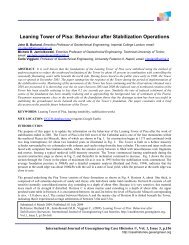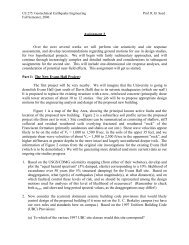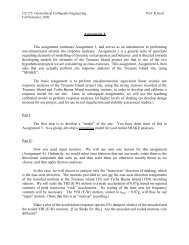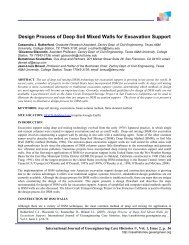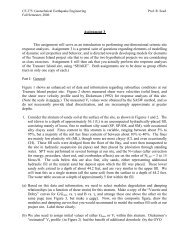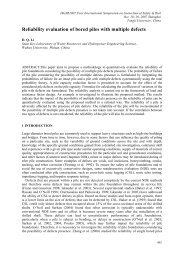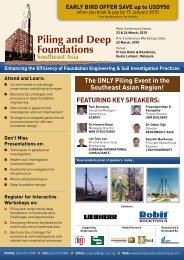Risk Assessment and Management for Offshore ... - GEOSNet
Risk Assessment and Management for Offshore ... - GEOSNet
Risk Assessment and Management for Offshore ... - GEOSNet
You also want an ePaper? Increase the reach of your titles
YUMPU automatically turns print PDFs into web optimized ePapers that Google loves.
7.3 <strong>Risk</strong> assessment <strong>and</strong> acceptable risk<br />
The geohazard risk has to be included in the overall project risk evaluation. If the risk<br />
contribution is significant <strong>and</strong> not acceptable, risk reducing measures should be sought (Fig. 1). In<br />
areas with significant natural slide hazard potential, this is primarily relocation of wells, structures<br />
<strong>and</strong> pipelines to less hazardous areas, alternatively to protect structures against slide impact.<br />
<strong>Risk</strong> assessment compares estimated level of risk with risk acceptance "criteria" <strong>and</strong> ranks<br />
scenarios or alternatives to establish priorities. Establishing "acceptable" <strong>and</strong> "tolerable" risk<br />
levels is difficult <strong>and</strong> can be the source of heated controversy. Existing target risk guidelines are<br />
generally based on engineering judgment <strong>and</strong> experience, <strong>and</strong> most of them suggest somewhat<br />
similar bounds of acceptable <strong>and</strong> unacceptable levels of annual probability of occurrence as<br />
functions of the consequence. International regulatory agencies have suggested risk criteria <strong>for</strong><br />
l<strong>and</strong> planning <strong>and</strong> managing industrial risks, e.g. the ALARP (As Low As Reasonably<br />
Practicable) principle (Health <strong>and</strong> Safety Executive, 1999; ANCOLD, 1996). The Whitman (1984)<br />
diagram (Fig. 4) provides an early example, with indication of tolerable risk <strong>for</strong> different facilities.<br />
Societal risks may also be expressed as curves of annual frequency of a threat (danger) causing<br />
fatalities, or any other consequences.<br />
Fig.4 Examples of proposed risk acceptance criteria<br />
(Left: ANCOLD, 1996; Right: Whitman, 1984)<br />
<strong>Risk</strong> mitigation is the process of selecting <strong>and</strong> implementing measures <strong>for</strong> managing the risks<br />
that have been identified. Low priority or acceptable risks may require no further consideration<br />
other than monitoring <strong>and</strong> periodic review. Other risks will require the identification <strong>and</strong><br />
evaluation of treatment options <strong>and</strong> the implementation of mitigation measures, including<br />
monitoring <strong>and</strong> periodic review.<br />
It should be noted that when computed risk levels <strong>for</strong> offshore geohazards are high, they could<br />
be a result of the large uncertainty associated with the strength <strong>and</strong> pore pressure data, <strong>and</strong> may<br />
indicate that more extensive investigations should be carried out.<br />
Human-induced risks can be reduced through careful planning <strong>and</strong> engineering aimed at<br />
minimizing effects of human influence, or by increasing the redundancy of the field development<br />
system.<br />
The assessment of geohazard risk must be based on available in<strong>for</strong>mation about regional <strong>and</strong><br />
local geology <strong>and</strong> site specific conditions regarding bathymetry, stratigraphy, soil conditions <strong>and</strong><br />
field exploration <strong>and</strong> lay-out plans. In areas with potential geohazards there should be a high<br />
degree of interaction between field development planning <strong>and</strong> geohazard evaluations. During the<br />
project development the amount of in<strong>for</strong>mation will increase, plans will typically be modified <strong>and</strong><br />
170



